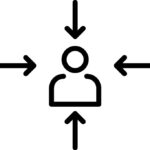After Children Have Attended
Children will experience many transitions in child care. Transitions can take many different forms in early childhood. Transitions can include to different classrooms within the same program, from one child care center to another, to public preschool, to public school, or from a center-based program to an in-home program (or vice versa). Looking at the roles that families play in the assessment process, let’s explore some ways families are involved after children attend a child care program or classroom.
The process of moving a child from one room to another in your program or helping the child and family to move from your program to a school setting is what transition is all about. Transition is change. You will want to keep in touch with your feelings and recognize which ones help you create positive partnerships in a child’s education.
There are a few things you need to remember
- Everyone has difficulty with change.
- We are often uneasy when we need more information.
- Many families benefit by thinking through the process; we need to give them time to go through it.
- Adjusting to a new setting with different requirements takes a lot of energy and effort.
Make sure parents have all information they need about their child’s development, progress, and goals as they move on to the next setting. When the time comes to transition from one setting to the next, forward any portfolios, assessments, or other documentation that has been maintained either to the new teacher or to the parent to share with the new teacher.
- Many families recall experiencing more anxiety than their children! Because they know their child best, ask them about their concerns and how you can help relieve some of the anxiety. Change can be scary but also exciting!
- Families are the expert on their child and just as they have shared information with you, it is important for them to continue sharing information in the next setting.
- The insight the family has gained from personal experience is equal to or as important as the information gathered by professionals. The family’s perceptions are needed to develop a complete picture of the child.
Help families prepare for the transition. When possible, help families and children transition to their new environment. If the setting is in the center, introduce the child and the family to the new setting location. Allow time for the parent to talk to the new teacher and discuss goals and strengths. Teachers should have time to meet to discuss what they have done and what they are working on with the child to ensure a smooth transition.
If they are transitioning out of the program, include, when possible, teachers or personnel at the new location.
- Talk with the family about all the new experiences they will have with their child this year and opportunities to become involved in the new setting.
- Each child is an individual, so sharing information about their child with those who will be working or caring for them will help the child.
- Families will find support and encouragement as they form relationships with other parents and professionals.
Regardless of where they are transitioning to, share assessment information with the families about where their child is at, goals they should be working on, skills they have that will support them, and skills the child may need to work on.
- Pair the family with another family who has already had a child transition to this same program or classroom, and they can share information.
- The family’s confidence will grow as they gain experience in supporting their child’s education in the new setting.
Transitions can be scary and nerve-wracking for families, especially during “big” transition times, such as from child care to school. Continue to make sure parents are aware of the resources available to them, people to contact (if applicable), and what supports their child will need in the new setting.
- Many families are concerned about their child being in a different setting. You can help them by answering questions about the new setting; if you don’t know the answers, refer them to someone who can answer them.
- Families will develop positive partnerships through their experiences and as they gain confidence in one another.
Did you know that supporting transitions is an All STARS Standard?
Programs should:
- Implement transition supports for children and families.
Want more information?
Check out this link for resources to help support transitions.






